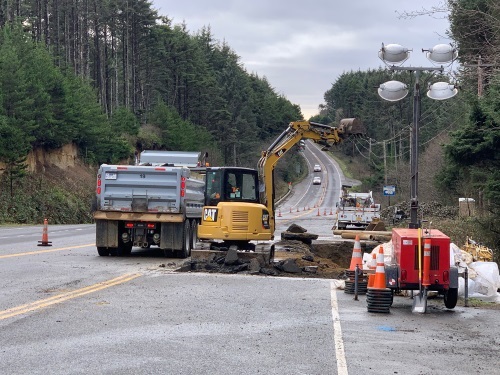The American Association of State Highway and Transportation Officials sent a letter on January 19 to Stephanie Pollack, deputy administrator of the Federal Highway Administration, registering feedback regarding the agency’s “policy guidance” for the $1.2 trillion Infrastructure Investment and Jobs Act or IIJA signed into law November 2021.
[Above photo by the Oregon DOT]
AASHTO said it “appreciates” FHWA’s acknowledgement that its guidance “does not suggest” that the agency has the authority to require state departments of transportation to invest federal formula funds in certain types of projects nor restrict them from investing in other types of projects.

“While the legislative process that led to the IIJA was certainly unconventional, the enacted legislation—and the Congressional intent regarding the Federal-aid Highway Program over the next five years—provides state DOTs with flexibility in how investment decisions are made with formula dollars to meet each state’s unique mobility and accessibility needs,” the organization said. “At the end of the day, collective efforts of states will go a long way in achieving the outcomes that are fundamentally agreed upon between FHWA and state DOTs.”
AASHTO emphasized that state DOTs balance “many different needs” when it comes to their respective transportation systems, ranging from managing existing assets for the long-term, system operations, demand management, strategic highway expansion, and additional capacity for other modes.
“State DOT investment strategies are not made in a vacuum,” AASHTO pointed out. “They must be made within the bounds of both federal requirements and the constitutional and statutory authority provided by state legislatures. Investment strategies and decisions reflect robust community engagement that informs long-range plans and transportation improvement programs developed with metropolitan and regional planning organizations.”

Further, AASHTO noted that – given their constrained financial resources – state DOTs engage in the management of their transportation assets through the utilization of a systems process and approach.
“Proposals to require ‘Fix it First’ solutions or prescribe the use of certain sources of funding for system preservation do not reflect the use of strategic planning but rather a one-size-fits-all approach to asset management,” the organization said. “Concerted asset management efforts by every state DOT over the past decade have resulted in improved outcomes on asset condition and system operations.”
AASHTO also noted that state DOTs are also taking a broad “multimodal” approach to managing current and future transportation demand, supporting transit system development and fostering active transportation growth where possible.

In 2019, for example, state DOTs invested $20.8 billion in public transportation, compared to the federal investment of $11.3 billion. In addition, 20 state agencies provided $750 million in funding support to Amtrak, providing service to 48 percent of its system-wide ridership.
Finally, AASHTO reiterated that – in the transportation sector – federal dollars play a relatively small role relative to total investment made in the United States. For instance, according to latest data from the Congressional Budget Office, only 22.3 percent of total transportation funding for capital, operations, and maintenance activities comes from the federal government. The remainder, or 76.7 percent, represents state and local government funding.
“How each state DOT uses its mix of funding sources for its investments varies greatly, reflecting the rich diversity and transportation needs across the country,” AASHTO emphasized. “That is why a one-size-fits-all approach would create unnecessary gaps and conflicts in meeting the various transportation challenges in each state.”



